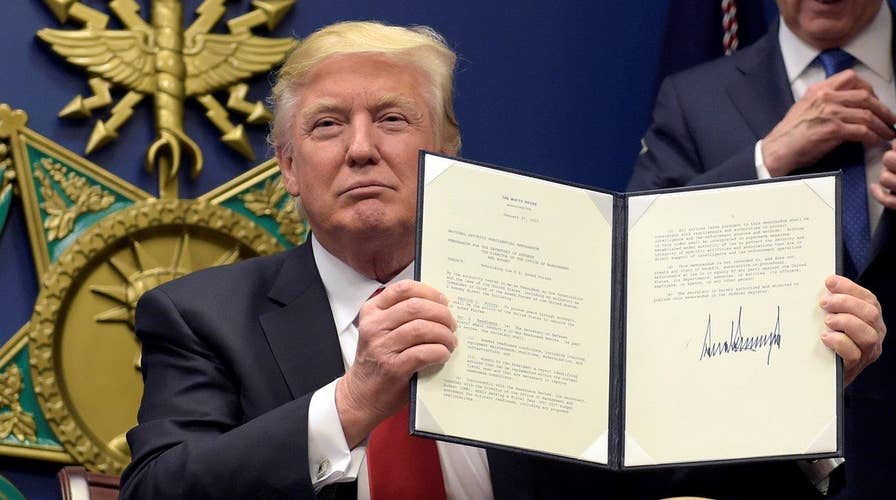Can DC adjust to President Trump's swift speed?
Political panel weighs in on the president's wave of executive actions
Perhaps it’s not so shocking that a man who confesses to getting about four hours of sleep per night is churning out executive orders and presidential memoranda at a furious pace.
But a comparison between Trump's first full week on the job and the agenda of several of his predecessors underscores just how quickly his administration has moved.
President Trump’s Week One schedule, counting Inauguration Day and the ensuing seven days, covered a grand total of six executive orders and eight memoranda.
This included: efforts to begin dismantling ObamaCare; withdrawing from the Trans-Pacific Partnership; freezing federal hiring and new government regulations; targeting sanctuary cities; beefing up border security; starting “extreme vetting;” ordering the construction of a southern border wall; restricting money to international organizations that perform abortions; and reviving the Keystone and Dakota Access pipelines.
As Sen. Jim Risch, R-Idaho, described it last week, the pace has been "dizzying."
The president's order Friday suspending the U.S. refugee program and taking other sweeping immigration measures has been the most controversial by far. But the actions nevertheless show Trump doing what he said he was going to do on the campaign trail -- and quickly.
“It’s classic President Donald Trump style,” White House counselor Kellyanne Conway told Fox News' “Justice with Judge Jeanine” on Saturday. “It’s exactly who he’s been in business, as a candidate, as president-elect and now president. He’s all about action and impact.”
For good measure, Trump also met with British Prime Minister Theresa May, called several world leaders, openly feuded with media organizations and Mexican President Enrique Pena Nieto, and sent out 69 tweets (not counting retweets) – 49 from his personal account and 20 from Trump’s newly acquired @POTUS.
Trump’s early pace of executive actions is similar to that of President Obama, who signed five executive orders and, according to one tally, nine memoranda in his first week.
Trump's actions, however, were more sweeping than Obama's.
And a review shows that Presidents George W. Bush and Clinton worked at a slower pace than either Obama or Trump in their opening days.
Bush’s only “action” was a restoration of the Mexico City Policy, which stops U.S. money from funding international groups that promote or perform abortions (which Trump also restored last week after it was revived under Obama). Otherwise, Bush’s efforts mostly were focused on stopping Clinton’s final deeds. He ordered a halt to the publication of new regulations and also issued instructions to slow the implementation of Clinton’s final executive orders.
Clinton’s early acts were focused on social policy, particularly abortion. He took steps to make RU-486 – an abortion drug – accessible, reversed a Department of Defense ban on abortion, issued an executive order to overturn a “gag rule” on doctors informing patients about abortion options and lifted a moratorium on federal funding of fetal tissue transplantation research.
Clinton also moved to proclaim a “National Day of Fellowship and Hope” and issued two executive orders: one making sure that senior employees signed ethics pledges and another establishing a National Economic Council.
Obama, after a successful campaign built on the concept of “change,” tried to swiftly turn concept into reality.
Obama issued executive orders from the start suspending all ongoing proceedings at Guantanamo Bay and requiring the Army Field Manual be used as a guide to terror interrogations. The order banned torture, after Obama during the campaign was highly critical of the practice of “waterboarding.”
Obama also enacted a pay freeze for senior White House staff who made more than $100,000, suspended pending federal regulations proposed by the Bush administration and made senior staff sign ethics rules regarding lobbying. On the environmental front, he ordered higher fuel efficiency standards and allowed states to raise emissions standards.
Fox News' Chad Pergram contributed to this report.





